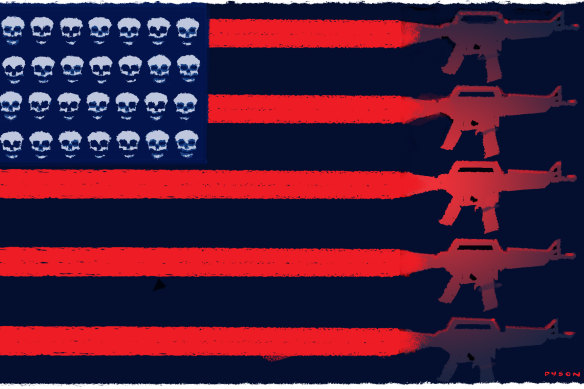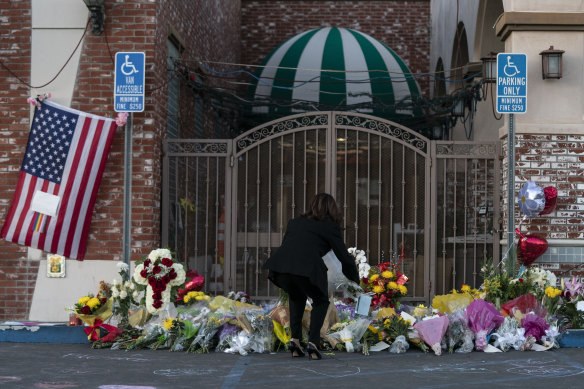This was published 2 years ago
Opinion
The only way America will ever solve its gun problem
Brad Emery
Freelance writerI can still remember the red trucker cap sporting the confederate flag and the stench of stale bourbon. It was my first bus trip in the American south and, just outside Greenville, South Carolina, we’d stopped at a ramshackle bus stop to take on passengers.
One of the new passengers plonked himself down next to me. He was missing several teeth and wearing what had once been a t-shirt.

Illustration by Andrew DysonCredit:
After some nervous banter, we ended up in lucid conversation about life in “the South” compared with life in Australia. South Carolina had only just passed laws allowing gun owners to carry licensed firearms concealed on their person, so it wasn’t long before the discussion turned to guns.
I explained how Australian gun laws worked and how they had changed over the years. I also explained that despite the tighter gun laws, sport shooters and hunters like me still had the freedom to pursue their sport.
“Gee,” the gent said, “I wish we had that. But I think it’s too late for us. The guy robbing my house has a .45, so I need a .45. If he’s got a pump action, I need a semi-auto 12 gauge.”
Therein lies the problem. Some see high-powered handguns with extended magazines and AR15 assault rifles with bump-stocks as an inalienable right to protect themselves should Patrick Swayze’s Red Dawn ever come to pass. Others are simply frightened to go downtown without a .22 automatic in their handbag.

US Vice President Kamala Harris lays flowers at a memorial set up outside Star Dance Studio in Monterey Park, California.Credit: AP
And the US gun lobby knows it. They know exactly which buttons to press. They know all you have to do is use the words “your rights”, “family”, “crime” and “government interference” in the appropriate order, and you’ll have ordinary Americans rushing to fill their gun safes and bedside tables with firearms.
That’s why we saw 10 people killed at a Lunar Festival dance in Monterey Park, California, last Saturday; seven more killed on Tuesday in Half Moon Bay, California; 19 children and two adults killed in a shooting at Robb Elementary School, in Uvalde County, in May 2022; Columbine, Colorado; Las Vegas; San Bernardino, California; Roseburg, Oregon; Newtown, Connecticut…
What will it take to change? It’s the question that parents, teachers, students, entire communities have been pleading to have answered. It’s a movement to which, after the Uvalde massacre, hometown boy Matthew McConaughey added his eloquent voice.
The “how” such a change would take place is complicated, and it would be naïve to think otherwise. But the “what” is simple. Until governors, state legislators, congress representatives, senators and even presidents of the United States are prepared to put their own political careers on the line, the blood of innocent Americans will continue to flow from gun violence.
Australia’s relatively recent history bears out this truth. Our country suffered its most hateful and deadly mass murder in April 1996, when Martin Bryant murdered 35 people – including children – using legally available military-style assault weapons.
Australia’s newly elected prime minister John Howard took immediate action, implementing federal firearm laws over and above state legislation. He risked his own political future by implementing federal legislation to ban all assault-style weapons and restricting all other semi-automatic rifles to rural landholders deemed to have a genuine need to manage feral animals.
At the next election, around a dozen members of parliament from the Howard government lost their seats, in no small measure due to the stand the government took on gun laws.
The price was worth it. Since 1996 there have been no repeats of the mass murder perpetrated at Port Arthur. At the same time the rights of recreational shooters – like myself – to own firearms have been upheld.
It’s true, there is still gun crime in Australia, predominantly related to illegally obtained weapons. However, there have been no mass killings on the scale our nation witnessed at Port Arthur in 1996 or those we see occurring almost monthly in the US since the Howard reforms were implemented.
To indicate how far the US is behind on implementing meaningful gun control at a federal level, consider this. In 2015, president Obama was fighting to have armour piercing ammunition removed from the shelves of gun stores. Eight years later, armour piercing ammunition is still sold on the open market in the USA.
There are flickers of hope. Some US administrations have tightened gun control more than others. Assault-style weapons, including the AR15, have been banned in nine US states and in Washington DC. Only 41 more states to go!
Unless we see a federal administration with the intestinal fortitude to make the hard calls that were made in Australia, regardless of the political price at the ballot box, mass murders like the two we saw this week will continue to stain the Stars and Stripes.
Brad Emery is a former staffer in the Howard government and a sport shooter.